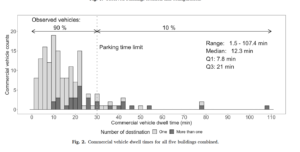Dwell time is defined as the time that delivery workers spend performing out-of-vehicle activities while their vehicle is parked. Restricting vehicle dwell time is widely used to manage commercial vehicle parking behavior. However, there is insufficient data to help assess the effectiveness of these restrictions. This makes it difficult for policymakers to account for the complexity of commercial vehicle parking behavior. A study by Kim, Goodchild, and Boyle aims to identify factors correlated with dwell time for commercial vehicles. This is accomplished by using generalized linear models with data collected from five buildings that are known to include commercial vehicle activities in the downtown area of Seattle, Washington, USA.
Their models showed that dwell times for buildings with concierge services tended to be shorter. Deliveries of documents also tended to have shorter dwell times than oversized supplies deliveries. Passenger vehicle deliveries had shorter dwell times than deliveries made with vehicles with roll-up doors or swing doors (e.g., vans and trucks). When there were deliveries made to multiple locations within a building, the dwell times were significantly longer than dwell times made to one location in a building.
The findings demonstrate the potential for improving future parking policies for commercial vehicles by considering data collected from different building types, goods delivered, and vehicle types. The dwell time models identified factors that can provide good estimates of commercial vehicle dwell times. Being able to estimate commercial vehicle dwell times provides for better predictions of commercial parking needs.
The models provide insights that can enhance parking policies by tailoring time limits and locations based on commercial vehicle needs. The analysis suggests the following recommendations for future parking policies:
- allow passenger load zone use for short commercial deliveries
- implement standardized delivery receipt policies aimed to reduce dwell times
- consider context-specific commercial vehicle parking time limits.
With additional dwell-time studies, cities can develop locally-specific policies that reduce unauthorized parking and its consequences, while best utilizing commercial parking spaces.
Source: Haena Kim, Anne Goodchild, Linda Ng Boyle, Empirical analysis of commercial vehicle dwell times around freight-attracting urban buildings in downtown Seattle, Transportation Research Part A: Policy and Practice,
Volume 147, 2021, Pages 320-338, ISSN 0965-8564 https://doi.org/10.1016/j.tra.2021.02.019.

